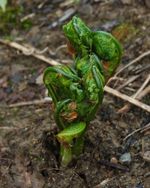Sansai


Sansai (山菜) is a Japanese word literally meaning "mountain vegetables", originally referring to vegetables that grew naturally were foraged in the wild, and not grown and harvested from fields. However in modern times, the distinction is somewhat blurred, as some sansai such as warabi have been successfully cultivated.[1]. For example, some of the fern shoots such as bracken and zenmai shipped to market are farm-grown.
There are often solde pre-cooked in water, and typically packaged in plastic packs in liquid. The fern shoots warabi (bracken), fuki stalks in sticks, and mixes which may contain the above mentioned combined with baby bamboo shoots, mushrooms, etc., are available in retail supermarkets, and even in ethnic foodstores in the US.
Sansai are often used as ingredients in shōjin ryōri, or Buddhist vegetarian cuisine.
Sansai include:
- [[{{{1}}}]] (Nemagaridake) - bamboo shoots of Sasa kurilensis[2].
- fuki-no-tō - flower shoots of buttebur (tō refers to a plant beginning to bolt)
- [[{{{1}}}]] (Allium victorialis) - similar to ramps (A. tricoccum)
- hana-ikada ([[{{{1}}}]]), young leaves[2].
- harigiri ([[{{{1}}}]])- Kalopanax species, young leaves tarter than tara[2].
- itadori (Polygonum cuspidatum) - Japanese knotweed[2]
- kogomi - fernbrakes of kusasotetsu (Matteuccia struthiopteris)[2]
- [[{{{1}}}]](Eleutherococcus sciadophylloides) - young leaves.[2]
- mitsuba
- miyama-irakusa [[{{{1}}}]] (Laportea macrostachya) - Nettlelike plants, which though young leaves and stems are eaten have stinging hairs requiring caution[2]
- momijigasa [[{{{1}}}]] (Parasenecio delphiniifolius, syn. Cacolia delphiniifolia) - an aster family plant, for young leaves and shoots[2]
- nirinsō ([[{{{1}}}]]) - young leaves are eaten but may be mistaken for wolfsbane[2]
- [[{{{1}}}]]- (Allium macrostemon) - similar to field garlic
- nogeshi - sowthistle (Sonchus oleraceus), for young leaves [2]
- seri - Japanese parsley
- sarunashi (Actinidia arguta) - fruits are eaten raw or to flavor alcohol[2]
- shiode (Smilax riparia var. ussuriensis) - young leaves[2]
- tara no me[2]
- tsuwabuki (Farfugium japonicum) - Stems prepard like fuki[3]
- udo - Japanese spikenard[2].
- uwabamisō (Elatostema umbellatum var. majus)[2]
- warabi - bracken shoots
- zenmai - another type of fern top, more prized than kogomi or warabi, and also sold dried.
References
- MAFF (December 2004). "山菜関係資料(Sansai-related material)" (PDF). Ministry of Agriculture. Retrieved 10 April 2012.
{{cite web}}: CS1 maint: date and year (link) (government website PDF)
